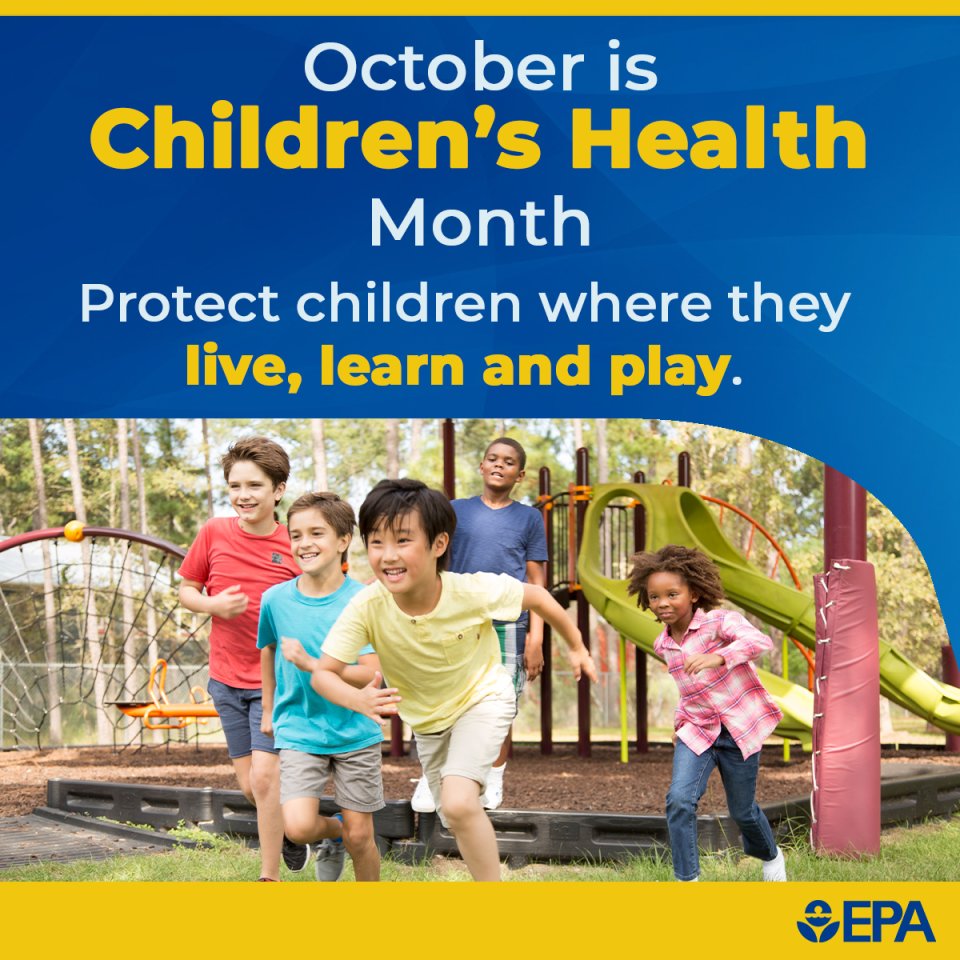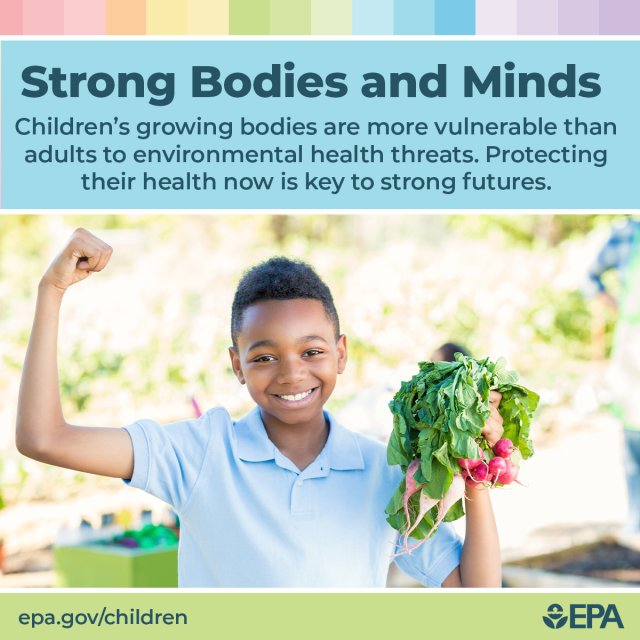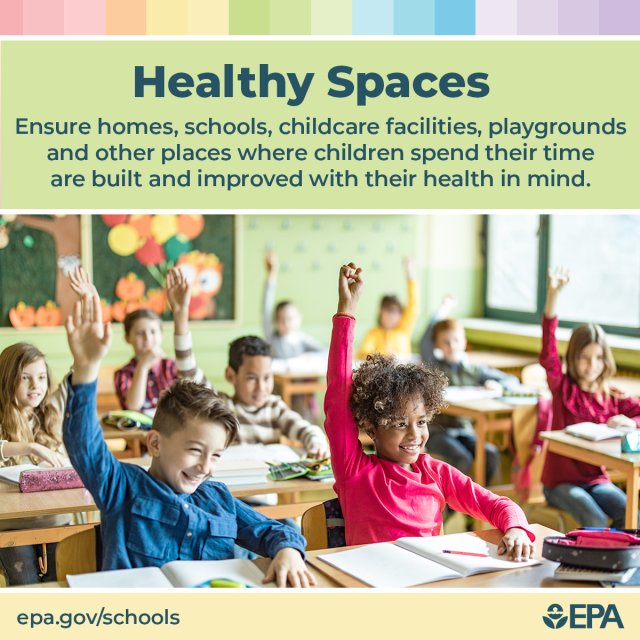Spotlight on EPA Research: Children’s Health Month

When most people think of October, they recall crisp days, the brilliant hues of changing leaves, and the infusion of pumpkin-spiced everything. Here's an additional reason to enjoy the tenth month of the year: October is National Children’s Health Month.Providing the data, information, and tools needed to better protect children’s health wherever they live, learn, and play has been a long-standing priority for EPA researchers and their partners.
Below are a few recent highlights of how EPA research has advanced children’s environmental health, showcasing another great reason to enjoy October.
Strong Bodies and Minds
Children's growing bodies are more vulnerable than adults to environmental health threats.
Under EPA leadership, children’s environmental health research has evolved into a distinct field of inquiry, sparking the development of new methods of study that fully recognize the unique risks that environmental exposures pose to children at every stage of development, even from before birth.

Our research program is designed in lockstep with caregivers, public health officials, and community decision makers in order to identify the most pressing environmental risks and to deliver research results that bridge the gap between emerging discoveries and actions that reduce risks and improve children's health.
The unparalleled record of achievement of the work has led to major breakthroughs in understanding the link between children’s health and the environment, delivering the information and tools needed to better protect children wherever they live, learn, and play.
Recent examples include advancing a new framework for considering children's environmental health, and several studies exploring the potential impact that environmental contaminants can have on healthy growth. Just a few examples include the following:
- EPA released the summary of one of the first workshops specifically devoted advancing a “Total Environment Framework” approach to children's environmental health: Evaluating Non-Chemical Stressors for Children’s Environmental Health Protection. “This workshop showed that non-chemical stressors from the built, natural, and social environments are interrelated and influence each other suggesting the challenge of selecting the most appropriate non-chemical stressors for research within the chemical stressor paradigm. Non-chemical stressors from the social environment are inextricably linked to non-chemical stressors from the built and natural environments,” notes the workshop summary.
- Learn more about the workshop and download a copy of “Evaluating Non-Chemical Stressors for Children’s Environmental Protection: Workshop Summary.
- Read the EPA story The Sum of the Parts: Developing a Systems-Level Approach to Protect Children’s Health.
- EPA researchers published results of a systematic review and meta-analysis review they conducted of the available scientific literature for epidemiological evidence of the association between short-term air pollution and infant mortality. The study is part of EPA's efforts to explore the unique health risks the very young face from exposure to air pollution.
Source: Luben, T. J., Wilkie, A. A., Krajewski, A. K., Njie, F., Park, K., Zelasky, S., & Rappazzo, K. M. (2023). Short-term exposure to air pollution and infant mortality: A systematic review and meta-analysis. Science of The Total Environment, 898, 165522. Learn more in about the published analysis in EPA's Science Inventory.
- Agency researchers explored the potential effects that maternal exposure to PFAS and other chemicals of concern have on normal and healthy and development. What they learn offers important clues to the health risks that children may face from such exposures.
Sources: Stoker, T. E., DeVane, G. D., Buckalew, A. R., Bailey, J. R., Ford, J. L., & Murr, A. S. (2024). Evaluation of the diphenyl herbicide, oxyfluorfen, for effects on thyroid hormones in the juvenile rat. Current Research in Toxicology, 6, 100146. Learn more about the paper in EPA's Science Inventory.
Conley, J. M., Lambright, C. S., Evans, N., Bangma, J., Ford, J., Hill, D., ... & Gray Jr, L. E. (2024). Maternal and Neonatal Effects of Maternal Oral Exposure to Perfluoro-2-methoxyacetic Acid (PFMOAA) during Pregnancy and Early Lactation in the Sprague–Dawley Rat. Environmental Science & Technology, 58(2), 1064-1075. Learn more about the published research in EPA's Science Inventory.
Conley, J. M., Lambright, C. S., Evans, N., Farraj, A. K., Smoot, J., Grindstaff, R. D., ... & Gray Jr, L. E. (2023). Dose additive maternal and offspring effects of oral maternal exposure to a mixture of three PFAS (HFPO-DA, NBP2, PFOS) during pregnancy in the Sprague-Dawley rat. Science of the Total Environment, 892, 164609. See a summary and a link to the published paper in the EPA Science Inventory.
Bright Futures Begin Lead Free
EPA researchers are exploring ways to identify and reduce lead exposure risks

Since its establishment in 1970, EPA has made reducing lead exposure to children a top EPA priority. And the Agency’s research program has played a critical role providing a strong scientific foundation to inform and support actions that have dramatically lowered blood levels in the nation’s children. But that and other research have also made it clear that when it comes to children, there is no safe level of lead exposure.
Accordingly, Agency researchers continue to provide cutting-edge science and technical support to those working to reduce lead wherever children may encounter it in their environment. What they learn is helping communities across the nation target sources of potential lead exposure and take action to eliminate them.
Recent examples include:
- Developing innovative, state-of-the science geospatial data analysis and screening approaches to help identify and address lead exposure hotspots. The work is aimed at helping EPA and partners target areas where children and others are most at risk to lead exposure and take action to reduce those risks.
Sources:
Zartarian Morrison, V., J. Xue, A. Poulakos, R. Tornero-Velez, L. Stanek, E. Snyder, V. Helms Garrison, K. Egan, AND J. Courtney. A U.S. Lead Exposure Hotspots Analysis. American Chemical Society, Washington, DC, 7(7):3311-3321, (2024). [DOI: 10.1021/acs.est.3c07881] Learn more about EPA research on lead hotspots.
Zartarian, V. G., Xue, J., Gibb-Snyder, E., Frank, J. J., Tornero-Velez, R., & Stanek, L. W. (2023). Children's lead exposure in the US: Application of a national-scale, probabilistic aggregate model with a focus on residential soil and dust lead (Pb) scenarios. Science of the Total Environment, 905, 167132. See the published paper from the National Library of Medicine.
- EPA researchers conducted a robust, multifaceted secondary analysis both biological and residential data to enhance the understanding of the links between lead exposure to pregnant women and those in early life stages of life. They found that demographic and housing characteristics were associated with both blood levels found in biological samples of pregnant women, and dust samples taken from residences. The work provides important clues for what actions can be effective in reducing lead exposure from where pregnant women and young children spend a majority of their time.
Source: Stanek, L. W., Grokhowsky, N., George, B. J., & Thomas, K. W. (2023). Assessing lead exposure in US pregnant women using biological and residential measurements. Science of the Total Environment, 905, 167135. Learn more about the published research and link to the journal article in EPA's Science Inventory.
Learn more about EPA Lead Research to Protect Children's Health.
Healthy Spaces
Our researchers are working to ensure homes, schools, childcare facilities, playgrounds, and other spaces are built and improved with children's health in mind.

EPA strives to protect children wherever they live, learn, and play. The Agency works with partners across the nation in states, local communities, tribal nations, and elsewhere to help ensure that homes, schools, childcare facilities, playgrounds, and other places where children spend their time are built and improved with their health in mind.
Those efforts are supported by a robust children’s health research program that includes both competitive grants and investigations conducted by EPA’s own staff scientists that is strategically designed to explore the links between the physical, built environment and exposure risks to children and pregnant women. Research teams are made of a diversity of experts so that emerging research results are immediately accessible to parents, health care professionals, caregivers, teachers, and others responsible for the care and safety of children.
Recent examples include the following:
- Research conducted by one of the EPA-funded Centers for Early Lifestage Vulnerabilities to Environmental Stressors is investigating whether caregiving environments affect neurodevelopment in early childhood. This is an ongoing project, split into two parts: the first part evaluates chemicals found in caregiving environments, and the second part addresses nonchemical factors, such as caregiving behaviors.
-
- Read the Press Release EPA Awards $3.8M to Create Research Centers for Early Childhood Developmental Health
- See results from the ongoing EPA grantee research project “Connecting Early Life Chemical Stressor and Caregiving Environment to Neurodevelopmental Outcomes for Children Attending Licensed Child Care Centers”
- Read the Press Release EPA Awards $3.8M to Create Research Centers for Early Childhood Developmental Health
-
- EPA researchers conducted a study to determine the effects of high-efficiency particulate (HEPA) filters in classrooms on children’s asthma. The results showed that after the installation of HEPA filters, the classrooms had reduced mold levels and the children's lung tests had improved. This study provides important insight into the potential benefits of air filtration in classrooms.
Source: Vesper, S., Wymer, L., Coull, B., Koutrakis, P., Cunningham, A., Petty, C., … & Metwali, N. (2023). HEPA filtration intervention in classrooms may improve some students' asthma. Journal of Asthma. Informa Healthcare, London, Uk, 60(3) 479-486. Read about the published results in the EPA Science Inventory.
- EPA researchers studied asthma prevalence in children living in a recently renovated apartment complex in Cincinnati, Ohio. By looking at medical records, they found that the average number of children diagnosed with asthma in this community decreased in the years following renovations. This work increases knowledge around the influence of housing quality on children’s health.
Source: Beck, A., Wymer, L., Pinzer, E., Friedman, W., Ashley, P. & Vesper, S. (2023). Reduced prevalence of childhood asthma after housing renovations in an under-resourced community. Journal of Allergy and Clinical Immunology: Global. Elsevier B.V., Amsterdam, Netherlands, 2(4), 100143. See a description of the research and find a link to the published results in EPA's Science Inventory.
Learn more about EPA Children's Health Research
